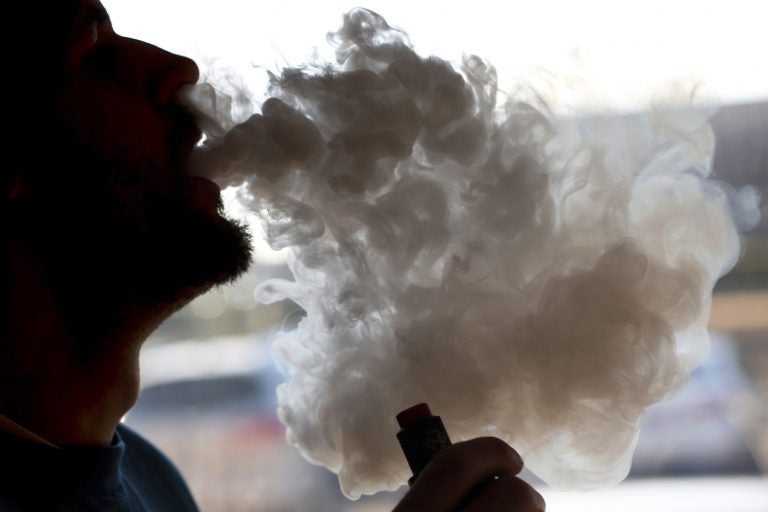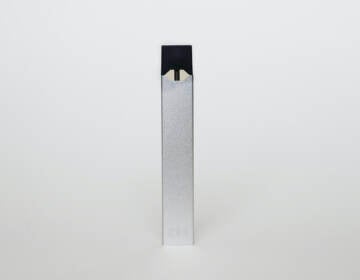State hospitals gather data to dispel smoke about vaping, e-cigs
As the number of teens and pre-teens vaping and using e-cigarettes continues to spike, some 70 hospitals across the state pool information and diagnoses.

In this Friday, Jan. 18, 2019 file photo, a man exhales a puff of smoke from a vape pipe at a shop in Richmond, Va. (AP Photo / Steve Helber)
This article originally appeared on NJ Spotlight.
–
Hospitals in New Jersey have seen e-cigarette use rise nearly two-thirds since 2017, and leaders want to learn more about what this means for patients’ health, including those who aren’t suffering from vape-related lung issues.
The New Jersey Hospital Association on Thursday released data that shows its 72 member hospitals are on track to care for more than 15,800 patients who report using e-cigarettes, or vapes, this year alone — up from just over 6,000 in 2017. Patients were treated for a wide range of conditions, not just those related to vaping.
The data — collected from insurance claims — also show e-cigarettes are becoming increasingly common among younger patients. Two years ago the NJHA reported e-cigarettes ticked up sharply starting at age 13; it now begins closer to age 11.
Patients between 18 and 24 were the most likely to report e-cigarette habits, and use rates were highest in Middlesex County, the figures show. Most are African American or white men, with Asians, Hispanics and women of all groups much less likely to partake.
Beyond the vaping headlines
While public health officials and media reports have largely focused on cases of vaping-related illness — which involves potentially fatal lung damage — the NJHA hopes that its ongoing data collection will shed light on the larger impact of e-cigarettes on their patients. The organization also wants to better understand who is using these devices and how hospitals can help curb what it sees as a growing public health threat.
“There is a collective concern and interest on behalf of New Jersey hospitals to work together” on this issue, said NJHA President and CEO Cathleen Bennett, who previously served as state health commissioner. The study was designed to see “what is the real penetration of e-cigarette use and what is its impact” on patients, she added.
One thing NJHA learned is that member hospitals need additional guidance in how to formally include vaping in patient records, Bennett said. In the coming weeks, the association will develop a toolkit for healthcare providers — in hospitals and private practice — to help them code e-cigarette use so it is properly recognized in the diagnoses and treatment plans.
With additional tools, “we can do a better job of not just counting e-cigarette use but understanding what is happening throughout the disparate populations in our state,” Bennett added.
Demand for consistent data
“The bottom line is we need good, consistent data in order to draw conclusions,” added Sean Hopkins, who leads the NJHA’s Center for Health Analytics, Research and Transformation, which conducted the review. “But this is an issue that is out of control and that is severely impacting health status.”
Bennett said some hospitals are also providing other patients, or public, services geared to reducing youth vaping, which soared nearly 80% among high school students nationwide in 2018 and rose 50% among middle-school pupils. Hackensack Meridian Health, one of the state’s largest health care networks, committed $1 million earlier this month to its “Take Vape Away” campaign, which involves grants to schools and community groups to educate young people about the dangers, a public health study and a partnership with mental health providers.
As of Tuesday, the federal Centers for Disease Control and Prevention was investigating nearly 1,900 cases of what it terms EVALI (for e-cigarette or vaping product use-associated lung injury) and has confirmed 37 deaths, including one in New Jersey.
According to the state Department of Health, New Jersey is currently home to 27 confirmed EVALI cases and 30 others are considered probable. (Another 29 are now under review.) Among the cases analyzed, the median age of the patients was 21 years and men outnumbered women by more than two to one.
Vaping products — which heat a liquid infused with nicotine or cannabinoids to create a vapor — do not produce cancer-causing tar-like cigarettes, but little is known about the health impact of the flavorings or other additives. And they can cause nicotine addiction. “The e-cigarette is essentially a delivery device for some kind substance,” Hopkins said.
Earlier this month, a task force appointed by Gov. Phil Murphy recommended a number of solutions to curb use among young people, including banning flavored e-cigarette products that experts believe are particularly attractive to children. Sen. Joe Vitale (D-Middlesex) has introduced a bill that would do so.
Diagnosing vaping-related health issues
Dr. Eric Costanzo, a pulmonologist at Jersey Shore University Medical Center in Neptune, which is part of the Hackensack Meridian system, said many of the patients he has treated with vaping-related concerns come in complaining of shortness of breath from what appears like congestion, fever and other symptoms that could be explained by an infection.
“You do an extensive infectious workup and it’s negative,” he said, “and when you’re doing a patient history and you ask the good questions, you learn these patients have been vaping.”
While physicians are compelled to rule out viral and bacterial infections, Costanzo said e-cigarette use “has to be on your radar screen when you make your differential diagnosis.”
The data collected by NJHA from January 2019 through August — which came from both inpatient and emergency-room discharge records — showed that of the approximately 10,000 patients that reported vape use, five diagnosis codes were most common. The top two related to chest pain, which could relate to shortness of breath, Costanzo noted, followed by fainting spells, lower back pain, and alcohol abuse.
More information is needed to understand if these diagnoses are associated with vape use, Bennett said, and public health officials must also carefully track nicotine dependence. While traditional cigarette addiction has declined significantly among youth in recent years, the rising use of vapes among pre-teens suggests more youngsters are becoming hooked on the drug.
Costanzo said he fears the numbers will “spike back up” for youth “unless we hit this (anti-vape message) aggressively and consistently.” He has volunteered with HMH to speak at schools and counsel his own three teenage children on how to avoid peer pressure to try e-cigs.
“We need to be aggressive in our preventative campaign,” Costanzo added. “We have a moral obligation to get into the schools and educate the children,” he continued. “The gravity of this needs to be expressed.”
WHYY is your source for fact-based, in-depth journalism and information. As a nonprofit organization, we rely on financial support from readers like you. Please give today.




